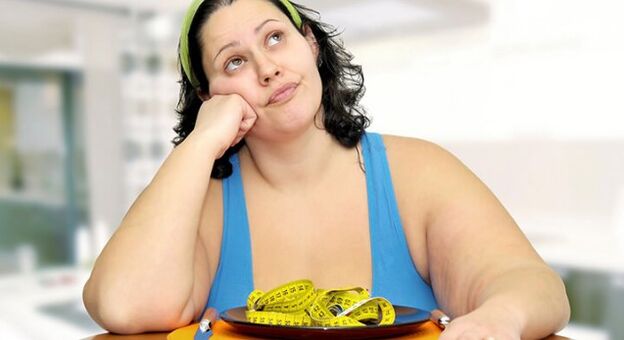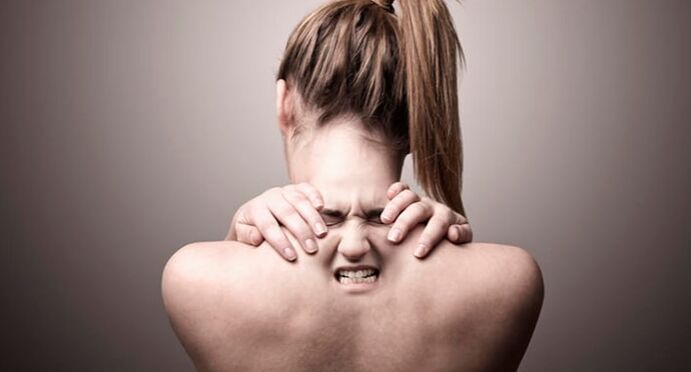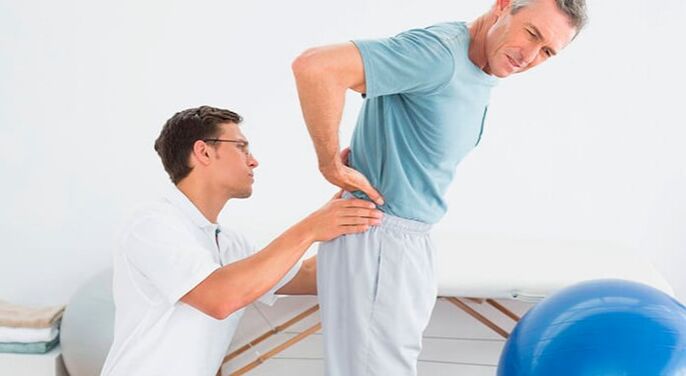Osteochondrosis is a common pathology to 40% of the population under 35-40 years and almost 90% in old age. Even in adolescents, signs of osteochondrosis are sometimes lowered -decreased disc height, pain, spinal discomfort. If you start the treatment of the disease in the first stage, before the destruction of the disc, the opportunity to stop development is very high.
What is osteochondrosis?

With spinal osteochondrosis, one or more intervertebral discs occur. The disease can occur anywhere -the department:
- Thoracic;
- Shein;
- Lumbar (lumbosacral).
In severe cases, the deterioration of the vertebrate against the background of osteochondrosis is observed throughout the pillar, which causes human defects. So what is this disease - osteochondrosis? This pathology is associated with a gradual, steady and progressive violation of Hyalin's cartilage diet located on the intervertebral disc, as a result they change their position, shape, cracks. A person has severe pain syndrome, the overall function of the musculoskeletal system.
What is osteochondrosis about the consequences? If you do not perform the treatment, the vertebrae will be compressed, the cracks between them will decrease, and the disc will appear to collapse. This will cause damage to the nerve roots, damage the spinal cord and the work of the defective internal organs. Bone osteophytes appear along the edge of the disc - a growth that causes more pain. The result of this spinal disease is very serious.
The main cause of osteochondrosis
Scientists conclude, studying osteochondrosis that the disease is a result of a person's habit, so most people are subject to it. Daily high burden on the spine, deterioration related to vascular function, low nutrition and body aging are the leading causes of osteochondrosis. The following factors are considered by the condition:
- Improper body position (for example, curved sitting at the table, wearing a bag on the shoulder);
- Sleep on soft mattresses, pillows;
- Flat feet, foot deformation;
- Metabolic disease;
- Excess weight creates an enhanced load on the vertebral column;
- Hypodynamia;
- Posture disruption;
- Various pregnancies;
- Long smoking experience;
- Vertebral instability.

Injuries, heavy physical activity exacerbated the development of spinal osteochondrosis. Therefore, athletes, physical labor workers, lower back osteochondrosis - a very "popular" problem. Descendants also play an important role in the pathogenesis of syndrome - if parents at a young age have serious problems with their backs, children are at high risk for spinal disease.
Psychosomatic osteochondrosis
The cause of psychosomatic pathology is a new direction in finding prerequisites for its formation. Psychosomatic implies the influence of psychological factors on development and physical illness. The connection between body and mental problems is really narrow, and in the appearance of a healthy person can experience normal pain. With osteochondrosis, some people have no objective reason for pathology, but they continue to grow.
Up to 30% of patients after a doctor's visit showed problems such as:
- Continuous pressure;
- Chronic experience;
- Nerve overstrain;
- Family problems;
- Conflict;
- Moral damage.
Stage of disease
The intervertebral disc is made up of liquid and solid parts. The first is in the middle, representing the core that provides elasticity. The core is surrounded by a strong ring from the top. It is with the fluid structure that all pathological changes in the disc begin, which then spread to the shell.
In medicine, four stages of the development of osteochondrosis are distinguished. This refers to a conditional pathology unit with the severity of the spinal cord:

- The first stage of osteochondrosis. The amount of moisture in the disk falls, it dehydration. Destruction has not occurred, but after severe dehydration of the nucleus on the fibrous ring, the microccrow begins. Symptoms at the level of the disease are usually absent.
- The second stage of osteochondrosis. The height of the disc begins to decrease, which means that the symptoms of symptoms and the development of pathology gradually. In the spine, the distance decreases between the individual segments, thus sagging ligaments. At this stage, in some patients, the disease causes vertebral - spondylolistz slip. Pain, discomfort occurs with severity, pain can be present even in remission.
- Third stage. Spinal osteochondrosis at this stage provides severe pain syndrome, as complications begin to form. Often, these are disc promotion, less frequent - arthrosis (degeneration) of vertebral joints, vertebral subluxation. The pain is supplemented by the limitations of the affected spinal segment mobility.
- The fourth stage of osteochondrosis. The spinal column begins to adapt to the new state of existence, trying to set the vertebra to protect it from the final destruction. For this, osteophytes develop. Pain can be hard due to injury to the nerve endings.
Symptoms of osteochondrosis
The first signs of osteochondrosis usually begin at an early stage when there is no pain. In the neck, lower back, less often - in the thoracic region when moving, you can hear the problem (this means disk power violation, dehydration). Further, during load, working in an uncomfortable position, one can see the stiffness of the back or neck muscles. They become "stones" on one or two sides, which are uncomfortable, causing burning, irritation.
Next, the symptoms of osteochondrosis become more clear. At rest, one can feel normal, but working, lifting weight, dreams on uncomfortable pillows can cause the phenomenon:
- Illness;
- Ill;
- Numbness of the hand (with damage to the neck);
- Feelings of stiffness;
- Forced decrease in movement;
- Muscle cramps;
- Celebration;
- Increased stress;
- Posture violations.

When burdening the patient's spine, osteochondrosis gives a more significant sign and symptoms. The pain occurs on the shoulder, giving it to his hands, elbows, headaches. With cervical spinal osteochondrosis, there is sound in the ear, dizziness, vertebral artery syndrome develops, and impaired vision. Over time, no muscle atrophy occurs without the treatment of osteochondrosis, the skin becomes pale. Cardiac pathology courses can be worsened, liver work, gall bladder, and gastrointestinal tract are disrupted.
What pathology leads to?
As a result of this disease is always unpleasant, they cause increased pain. With osteochondrosis, there is:
- Disk protrusion;
- Disk prolapse and hernia;
- Attacks of radiculitis, ishias, lumbago;
- Kyphosis, scoliosis.
The danger to a person largely depends on the type of hernia for spinal osteochondrosis. They are front, back, sides, and most dangerous are the back hernia - they can squeeze the spinal cord. In the lumbar segment of the spinal cord, the hernia is the most common, especially between 4-5 vertebrae.
Lumbar osteochondrosis can cause very unpleasant symptoms - lumbago. Lumbago pain is burning, sharp, unbearable, very difficult to survive. The cause is pinching the nerves, as the patient is damaged by the neuromusive bundle. Especially dangerous for osteochondrosis of horse tail syndrome, when one has pinching a large group of spinal cord. As a result, intestinal function, bladder, can even occur even in paralysis.

Signs of osteochondrosis often go down to severe muscle atrophy. If the muscles do not take part in the body for a long time, the movement of the spine is constrained, then the individual fiber weakens. As a result, the patient can be a disabled person who is chained to bed. Cervical osteochondrosis is also very dangerous, as the hernia in this segment can cause blood supply to the brain. At this stage there is a risk of visual, swallowing, speech and other brain function.
Diagnosis of a disease
Independently recognizes the signs of osteochondrosis, you need to consider the treatment. Because spinal lesions can reach different levels, the treatment of osteochondrosis is also uneven. It is important to make the right diagnosis so that therapy is selected correctly.
Due to the prevalence of the disease and the presence of symptom symptoms, the doctor will be able to consider the diagnosis at an initial examination. But for the differentiation of osteochondrosis from other diseases from the back and internal organs, the following diagnosis is performed:
- X -ray spine. It will help identify the height of the disc, the level of thinning, as well as the presence of osteophytes.
- Ct, MRI. Preferably in the exam. With this disease, the severity of damage to the nerves, soft tissues, and finding the smallest protrusion will allow to determine.
With osteochondrosis, laboratory tests do not play an important role, but the delivery of general analysis, biochemistry is required to exclude the inflammatory process, bone rheumatoid wounds, joints. To study muscle function, doctors conducted several physical tests, and to explain blood vessels and nerves, they did duplex, electromilography.
Treatment of osteochondrosis drug
If the symptoms and treatment of osteochondrosis are determined, it is not worth slowing down the therapy - the disease develops rapidly. In the early stages, gymnastics are usually recommended, massage to strengthen the muscles - this will be sufficient. At the osteochondrosis stage, drug treatment is required, and sometimes surgery.
Relieving pain is the most unpleasant sign of the disease -you can use anti -non -ssteroid inflammation. They cannot cure osteochondrosis, but they are always prescribed before exercise therapy to relieve symptoms. In severe cases, drugs are administered in injections, but more often they are recommended by a 7-14 day course in tablets and local, in the form of ointment.
If a person has painful syndrome in the spine, he or she is injected with a glucocorticosteroid injection directly into the damage zone.
Treatment of osteochondrosis is also performed using the following methods:
- B Vitamin B. Helps improve the conductivity of the spinal cord.
- Chondroprotectors. They nourish the intervertebral cartilage, strengthening the disc.
- Musorelaxants. Reduce muscle cramps for osteochondrosis.
- Vascular medicine. Optimize blood circulation in the spine.
If osteochondrosis has developed, then only chondroproprotectors provide anesthesia and pathogenetic treatment, they are taken in courses for 3-6 months. The rest of the medicine has the effects of symptoms and does not affect the journey of osteochondrosis itself.
Physiotherapy and osteochondrosis

In the list of steps from treating osteochondrosis, physiotherapy techniques should be included. Thanks to physiotherapy, the treatment of osteochondrosis will be more effective, as the action extends directly to the focus of inflammation. Physiotherapy will relieve painful syndrome, eliminate cramps, improve blood circulation, help remove clips from the nerves. The most popular methods are as follows:
- Electrophoresis. Treatment of osteochondrosis in this way will allow to deliver relaxing, anti -inflammatory and anesthetic materials directly to the vertebral, muscle, ligaments.
- Ultrasound. Relieves unpleasant symptoms, anesthesia, creates the effects of vibration sequence, activating local metabolism.
- Magnetotherapy. The continuous variation or magnetic field eliminates the inflammation process.
All types of physiotherapy should be carried out by a course of 10-15 procedures, while individual contraindications should be taken into account.
Gymnastics and massage
Exercise therapy in the treatment of osteochondrosis plays a dominant role. Without exercise therapy, it is not possible to form a strong muscle corset, and the latter is essential to maintaining a sore spine. Also, gymnastics improves blood circulation in the vertebral zone, improves metabolic processes and helps to quickly produce damage products.
How to cure osteochondrosis with gymnastics? The complex is selected only individually, and only at level 1-2 it can be carried out without the control of the doctor. In later stages, unnecessary and strong movements can cause disk spread and strengthen the problem. In 3 stages, all exercises are done only in a lying position.
For the treatment of osteochondrosis, massage is required. At the acute level, they don't do it - this will cause fun. But properly done massage at the chronic stage with osteochondrosis is essential. After the session, the muscles rest, the clamps are removed, the nerves and blood vessels begin to function normally. Massage is only carried out in soft mode, without sudden movement.

Pathological prevention
In order not to bring surgery to osteochondrosis, it is important to carefully consider the steps: Preventive Steps:
- Don't let hypodynamia. The disease can advance with the burden of power, but swimming, skiing, charging will only benefit and help strengthen the muscles and overall health.
- Follow the posture. At work and at home, it is important to sit properly, not to sharpen, and from children's time.
- Sleep on a comfortable pillow. There are preventive pillows, with existing osteochondrosis, some others, therapeutic is used.
- Don't lift weights. If necessary, you need to sit, get up with an object, hold your straight back.
- Regularly performs classes to strengthen the muscles. This is important for the neck, back, press, lower back.
- Wear comfortable shoes. Orthopedic shoes will not allow risk factors to defeat the vertebra.
It is also important to eat well, not smoke, enrich your diet with vitamins, take more fluids - so the probability of pathology will decrease.






















